oil level DODGE DURANGO 2008 2.G Owners Manual
[x] Cancel search | Manufacturer: DODGE, Model Year: 2008, Model line: DURANGO, Model: DODGE DURANGO 2008 2.GPages: 481, PDF Size: 7.75 MB
Page 391 of 481

MAINTENANCE PROCEDURES
The pages that follow contain therequiredmaintenance
services determined by the engineers who designed your
vehicle.
Besides the maintenance items for which there are fixed
maintenance intervals, there are other items that should
operate satisfactorily without periodic maintenance.
However, if a malfunction of these items does occur, it
could adversely affect the engine or vehicle performance.
These items should be inspected if a malfunction is
observed or suspected.
Engine Oil
Checking Oil Level
To assure proper lubrication of your vehicle's engine, the
engine oil must be maintained at the correct level. The
best time to check the engine oil level is about 5 minutes
after a fully warmed up engine is shut off or before
starting the engine after it has sat overnight.
Checking the oil while the vehicle is on level ground will
improve the accuracy of the oil level readings. Always
maintain the oil level within the SAFE zone on the
dipstick. Adding one quart of oil when the reading is at
the bottom of the SAFE zone will result in a reading at the
top of the safe zone on these engines.
MAINTAINING YOUR VEHICLE 391
7
Page 402 of 481
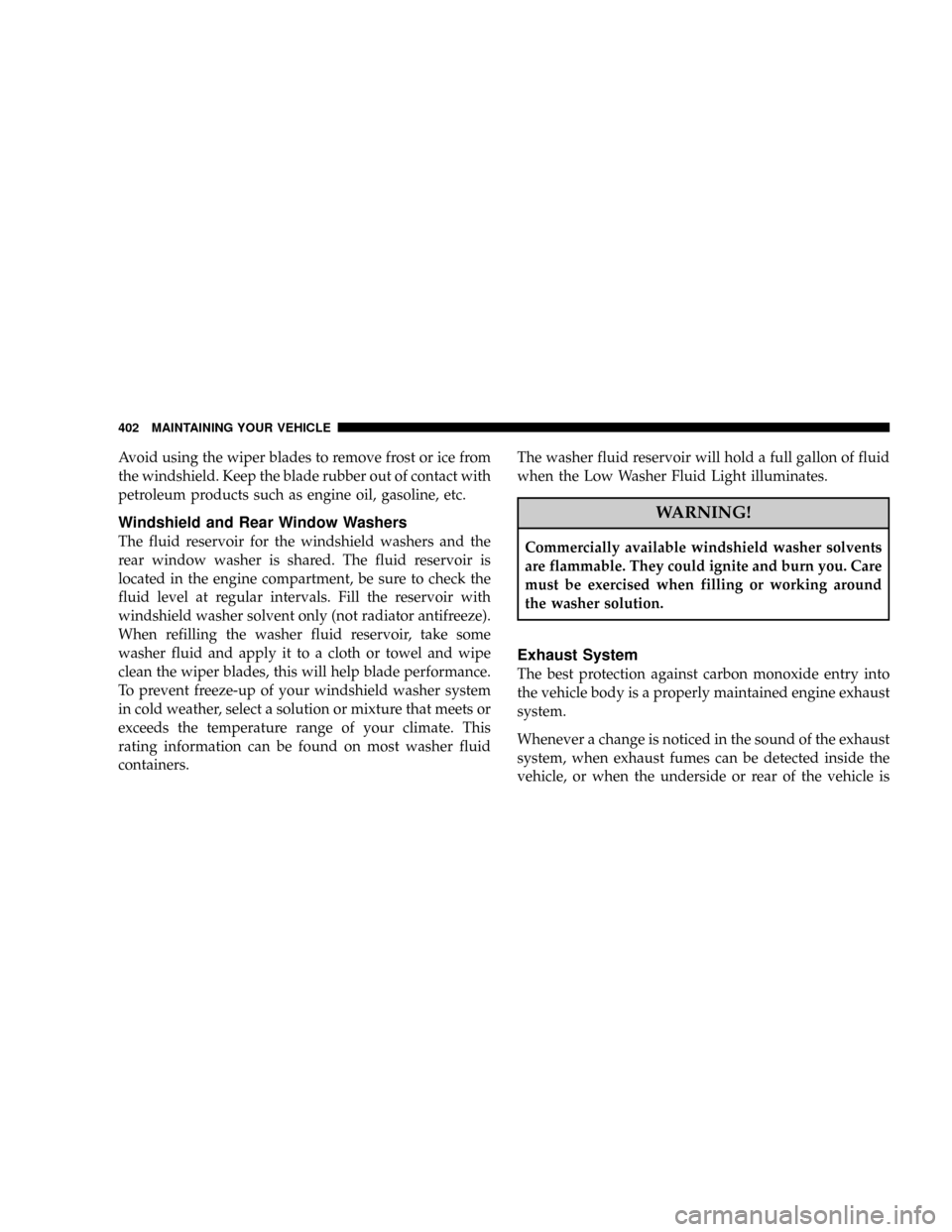
Avoid using the wiper blades to remove frost or ice from
the windshield. Keep the blade rubber out of contact with
petroleum products such as engine oil, gasoline, etc.
Windshield and Rear Window Washers
The fluid reservoir for the windshield washers and the
rear window washer is shared. The fluid reservoir is
located in the engine compartment, be sure to check the
fluid level at regular intervals. Fill the reservoir with
windshield washer solvent only (not radiator antifreeze).
When refilling the washer fluid reservoir, take some
washer fluid and apply it to a cloth or towel and wipe
clean the wiper blades, this will help blade performance.
To prevent freeze-up of your windshield washer system
in cold weather, select a solution or mixture that meets or
exceeds the temperature range of your climate. This
rating information can be found on most washer fluid
containers.The washer fluid reservoir will hold a full gallon of fluid
when the Low Washer Fluid Light illuminates.
WARNING!
Commercially available windshield washer solvents
are flammable. They could ignite and burn you. Care
must be exercised when filling or working around
the washer solution.
Exhaust System
The best protection against carbon monoxide entry into
the vehicle body is a properly maintained engine exhaust
system.
Whenever a change is noticed in the sound of the exhaust
system, when exhaust fumes can be detected inside the
vehicle, or when the underside or rear of the vehicle is
402 MAINTAINING YOUR VEHICLE
Page 410 of 481
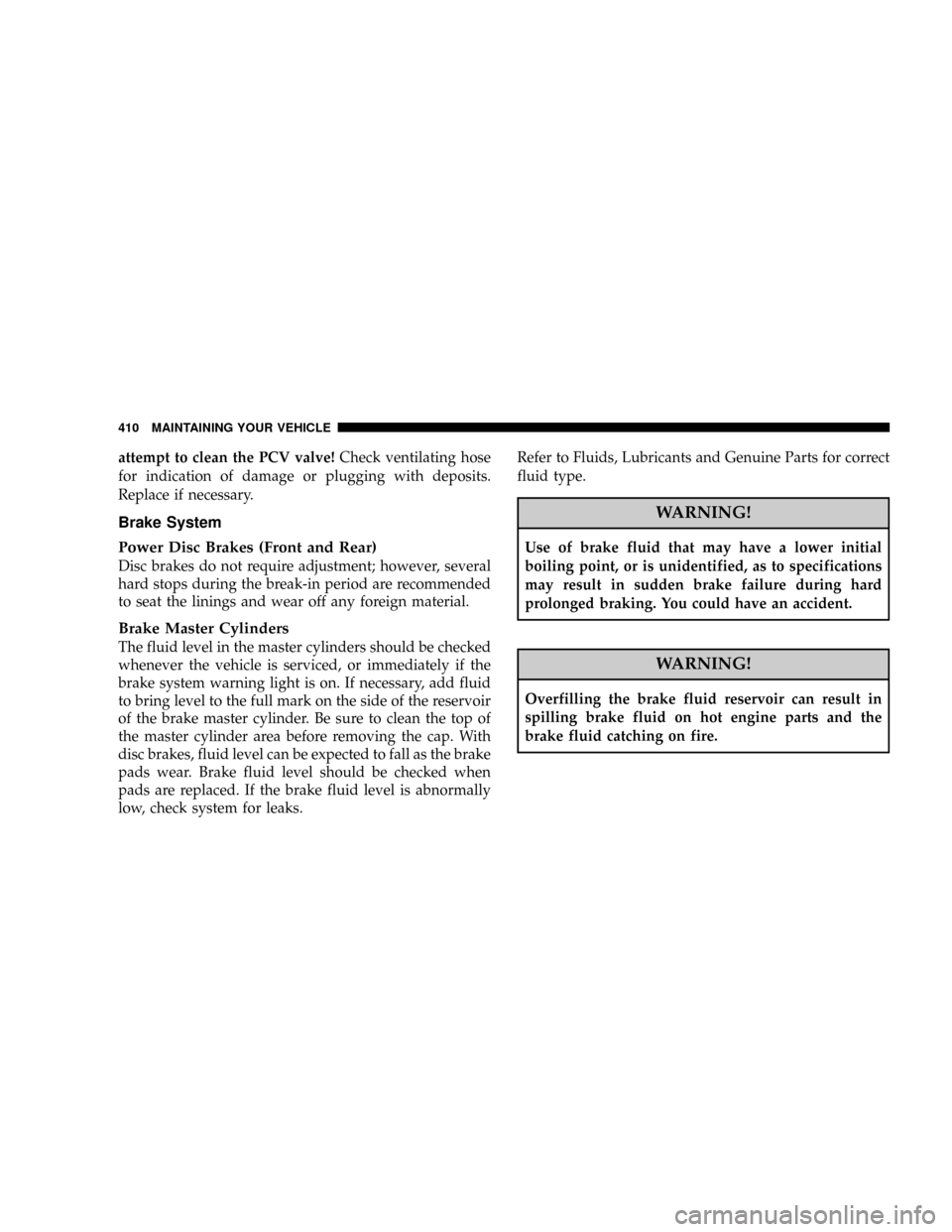
attempt to clean the PCV valve!Check ventilating hose
for indication of damage or plugging with deposits.
Replace if necessary.
Brake System
Power Disc Brakes (Front and Rear)
Disc brakes do not require adjustment; however, several
hard stops during the break-in period are recommended
to seat the linings and wear off any foreign material.
Brake Master Cylinders
The fluid level in the master cylinders should be checked
whenever the vehicle is serviced, or immediately if the
brake system warning light is on. If necessary, add fluid
to bring level to the full mark on the side of the reservoir
of the brake master cylinder. Be sure to clean the top of
the master cylinder area before removing the cap. With
disc brakes, fluid level can be expected to fall as the brake
pads wear. Brake fluid level should be checked when
pads are replaced. If the brake fluid level is abnormally
low, check system for leaks.Refer to Fluids, Lubricants and Genuine Parts for correct
fluid type.
WARNING!
Use of brake fluid that may have a lower initial
boiling point, or is unidentified, as to specifications
may result in sudden brake failure during hard
prolonged braking. You could have an accident.
WARNING!
Overfilling the brake fluid reservoir can result in
spilling brake fluid on hot engine parts and the
brake fluid catching on fire.
410 MAINTAINING YOUR VEHICLE
Page 412 of 481

least 15 miles (24 km) of driving. At normal operating
temperature the fluid cannot be held comfortably be-
tween the fingertips.
To check the automatic transmission fluid level properly,
the following procedure must be used:
1. Operate the engine at idle speed and normal operating
temperature.
2. The vehicle must be on level ground.
3. Fully apply the parking brake and press the brake
pedal.
4. Place the gear selector momentarily in each gear
position ending with the lever in P (Park).
5. Remove the dipstick, wipe it clean and reinsert it until
seated.
6. Remove the dipstick again and note the fluid level on
both sides. The fluid level should be between the ªHOTº(upper) reference holes on the dipstick at normal operat-
ing temperature. Verify that solid coating of oil is seen on
both sides of the dipstick. If the fluid is low, add as
required into the dipstick tube.Do not overfill.After
adding any quantity of oil through the oil fill tube, wait
a minimum of two (2) minutes for the oil to fully drain
into the transmission before rechecking the fluid level.
NOTE:If it is necessary to check the transmissionbelow
the operating temperature, the fluid level should be
between the two ªCOLDº (lower) holes on the dipstick
with the fluid at approximately 70ÉF ( 21ÉC) (room
temperature). If the fluid level is correctly established at
room temperature, it should be between the ªHOTº
(upper) reference holes when the transmission reaches
180ÉF ( 82ÉC). Remember it is best to check the level at the
normal operating temperature.
412 MAINTAINING YOUR VEHICLE
Page 445 of 481
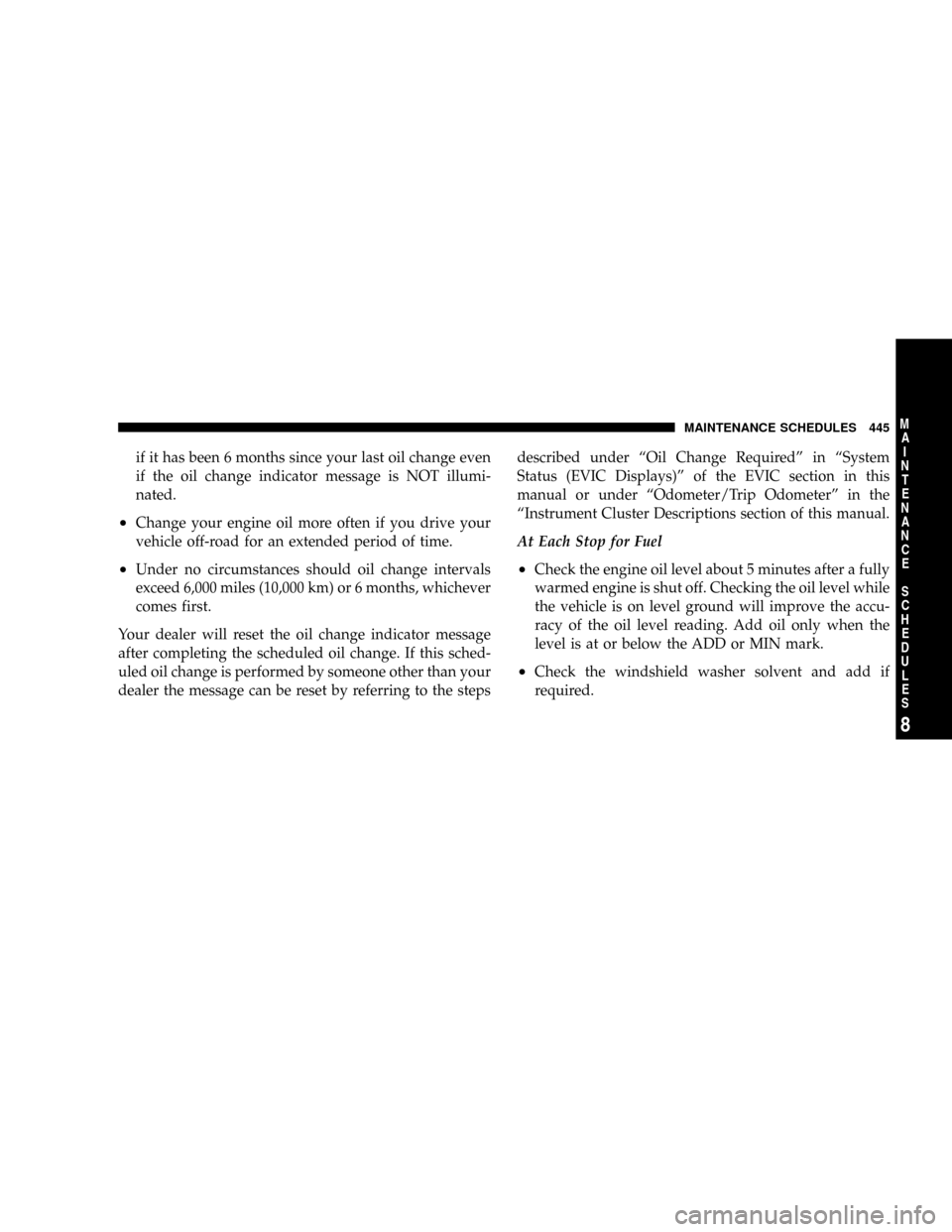
if it has been 6 months since your last oil change even
if the oil change indicator message is NOT illumi-
nated.
²Change your engine oil more often if you drive your
vehicle off-road for an extended period of time.
²Under no circumstances should oil change intervals
exceed 6,000 miles (10,000 km) or 6 months, whichever
comes first.
Your dealer will reset the oil change indicator message
after completing the scheduled oil change. If this sched-
uled oil change is performed by someone other than your
dealer the message can be reset by referring to the stepsdescribed under ªOil Change Requiredº in ªSystem
Status (EVIC Displays)º of the EVIC section in this
manual or under ªOdometer/Trip Odometerº in the
ªInstrument Cluster Descriptions section of this manual.
At Each Stop for Fuel²Check the engine oil level about 5 minutes after a fully
warmed engine is shut off. Checking the oil level while
the vehicle is on level ground will improve the accu-
racy of the oil level reading. Add oil only when the
level is at or below the ADD or MIN mark.
²Check the windshield washer solvent and add if
required.
MAINTENANCE SCHEDULES 445
8
M
A
I
N
T
E
N
A
N
C
E
S
C
H
E
D
U
L
E
S
Page 446 of 481
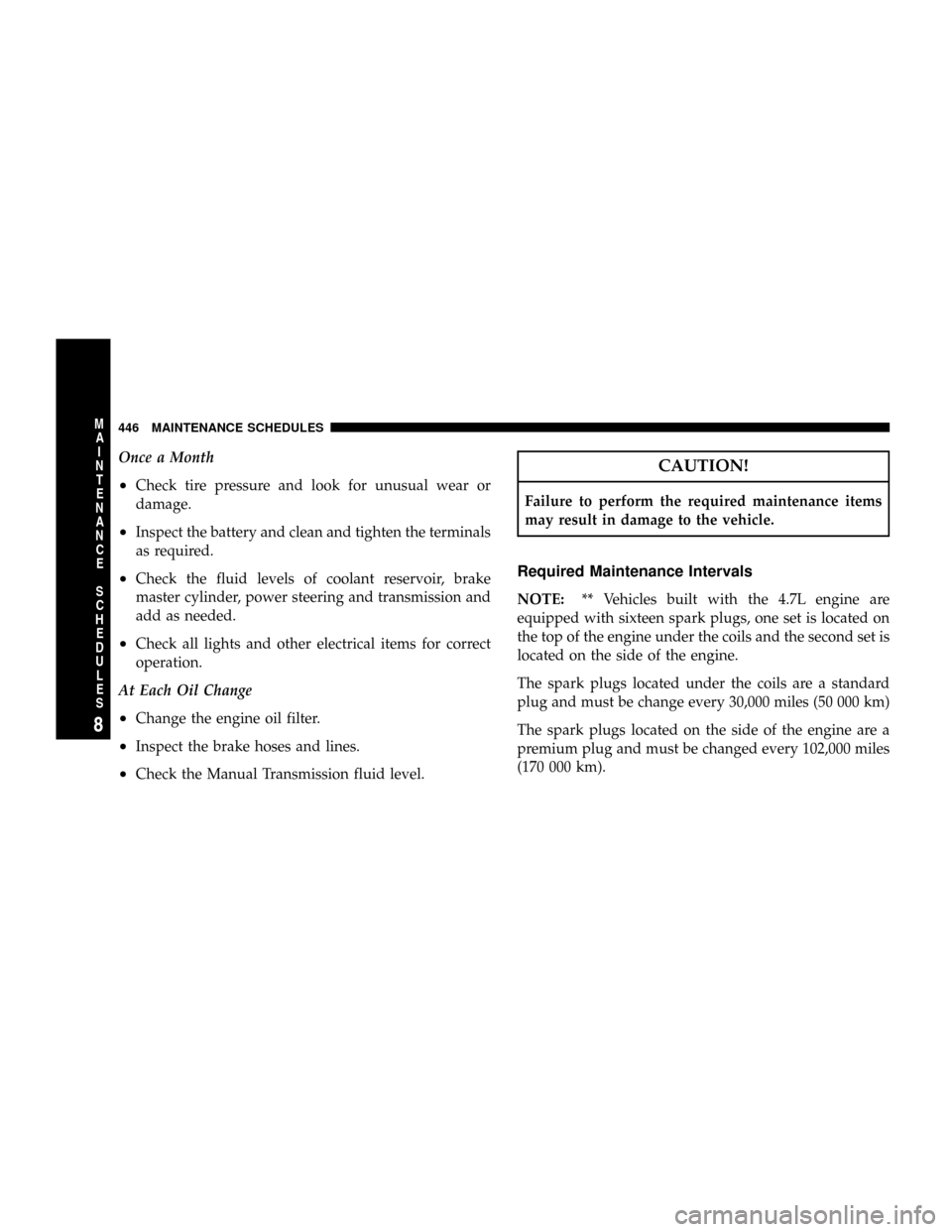
Once a Month
²Check tire pressure and look for unusual wear or
damage.
²Inspect the battery and clean and tighten the terminals
as required.
²Check the fluid levels of coolant reservoir, brake
master cylinder, power steering and transmission and
add as needed.
²Check all lights and other electrical items for correct
operation.
At Each Oil Change
²Change the engine oil filter.
²Inspect the brake hoses and lines.
²Check the Manual Transmission fluid level.
CAUTION!
Failure to perform the required maintenance items
may result in damage to the vehicle.
Required Maintenance Intervals
NOTE:** Vehicles built with the 4.7L engine are
equipped with sixteen spark plugs, one set is located on
the top of the engine under the coils and the second set is
located on the side of the engine.
The spark plugs located under the coils are a standard
plug and must be change every 30,000 miles (50 000 km)
The spark plugs located on the side of the engine are a
premium plug and must be changed every 102,000 miles
(170 000 km).
446 MAINTENANCE SCHEDULES
8
M
A
I
N
T
E
N
A
N
C
E
S
C
H
E
D
U
L
E
S
Page 465 of 481

Adding Coolant (Antifreeze).............. 405
Coolant Capacity...................... 439
Coolant Level......................403,407
Disposal of Used Coolant................ 407
Drain, Flush, and Refill.................. 404
Inspection........................... 407
Points to Remember.................... 407
Pressure Cap......................... 406
Radiator Cap......................... 406
Selection of Coolant (Antifreeze)......404,439,440
Temperature Gauge..................... 193
Cruise Control (Speed Control).............. 149
Cup Holder............................ 181
Customer Assistance..................... 452
Data Recorder, Event...................... 62
Daytime Running Lights................... 141
Dealer Service.......................... 390
Defroster, Rear Window................... 267Defroster, Windshield.............76,254,259,260
Delay (Intermittent) Wipers................. 144
Diagnostic System, Onboard................ 387
Digital Video Disc (DVD) Player..........206,236
Dimmer Switch, Headlight................. 194
Dipsticks
Automatic Transmission................. 411
Oil (Engine).......................... 391
Power Steering........................ 399
Disarming, Theft System................... 19
Disc Brakes............................ 410
Disposal
Antifreeze (Engine Coolant)............... 407
Door Locks............................. 28
Door Locks, Automatic.................... 162
Door Opener, Garage..................... 168
Drive Belts............................ 394
Drive Shaft Universal Joints................ 401
INDEX 465
10
Page 467 of 481

Oil ...........................391,439,440
Oil Filler Cap.................384,385,386,393
Oil Selection.......................393,439
Oil Synthetic......................... 394
Starting............................. 273
Temperature Gauge..................... 193
Entry System, Illuminated.................. 20
Equipment Identification Plate.............. 364
Event Data Recorder...................... 62
Exhaust Gas Caution..............39,75,336,403
Exhaust System.......................75,402
Extender, Seat Belt........................ 52
Exterior Lighting........................ 140
Fabric Care............................ 417
Filters
Air Cleaner.......................... 395
Engine Fuel.......................... 396
Engine Oil........................394,440Engine Oil Disposal.................... 394
Flashers
Hazard Warning....................... 366
Turn Signal.....................142,193,432
Flat Tire Stowage.....................368,374
Flexible Fuel Vehicles
Cruising Range........................ 342
Engine Oil........................... 341
Fuel Requirements..................339,340
Maintenance.......................... 342
Replacement Parts..................... 342
Starting............................. 341
Flooded Engine Starting................... 274
Floor Console.......................181,182
Fluid, Brake.........................410,441
Fluid Capacities......................... 439
Fluid Level Checks
Automatic Transmission................. 411
Brake............................... 410
INDEX 467
10
Page 481 of 481
INTRODUCTION INTRODUCTION ROLLOVER WARNING HOW TO USE THIS MANUAL WARNINGS AND CAUTIONS VEHICLE IDENTIFICATION NUMBER VEHICLE MODIFICATIONS/ALTERATIONS THINGS TO KNOW BEFORE STARTING YOUR VEHICLE A WORD
ABOUT YOUR KEYS Ignition Key RemovalLocking Doors With The KeySENTRY KEY Replacement KeysCustomer Key ProgrammingGeneral InformationIGNITION AND STEERING LOCK Ignition Accessory Delay FeatureSECURITY ALARM SYSTEM - IF EQUIPPED
To Set the AlarmTo Disarm the SystemILLUMINATED ENTRY Vehicles Equipped With Power Door LocksREMOTE KEYLESS ENTRY To unlock the doors and liftgateTolock the doors and liftgateUsing the Panic AlarmGeneral InformationProgramming Additional Transmitters
Battery ReplacementREMOTE STARTING SYSTEM - IF EQUIPPED DOOR LOCKS Manual Door LocksPower Door LocksChild Protection Door LockWINDOWS Power Windows Auto DownAuto Up Feature with Anti-Pinch Protection (Drivers and Front Passenger Door
Only)Window Lockout SwitchLIFTGATE Power Liftgate - If EquippedOCCUPANT RESTRAINTS Lap/Shoulder BeltsAdjustable Upper Shoulder Belt AnchorageSecond Row Center Seat BeltAutomatic Locking Retractors (ALR) Mode - If EquippedRear 60/40 Seat Third Row
Center Three Point Belt - If EquippedSeat Belt PretensionersEnhanced Driver Seat Belt Reminder System (BeltAlert) Seat Belts and Pregnant WomenSeat Belt ExtenderDriver And Right Front Passenger Supplemental Restraint System (SRS)-Airbags Event Data Recorder
(EDR)Child RestraintENGINE BREAK-IN RECOMMENDATIONS SAFETY TIPS Exhaust SystemSafety Checks You Should Make Inside The VehicleSafety Checks YouShould Make Outside The VehicleUNDERSTANDING THE FEATURES OF YOUR VEHICLE MIRRORS
Inside Day/Night MirrorAutomatic Dimming Mirror - If EquippedOutside MirrorsExterior Mirrors Folding Feature - If EquippedElectric Remote-Control MirrorsIlluminated Vanity Mirrors - If EquippedHeated Mirrors - If EquippedAutomatic Dimming Drivers Exterior Mirror - If
EquippedHANDS-FREE COMMUNICATION (UConnect) - IF EQUIPPED OperationPhone Call FeaturesUConnect System FeaturesAdvanced Phone ConnectivityThings You Should Know About Your UConnect SystemGeneral InformationSEATS Front Seat Manual Seat
AdjustmentFront Seats Manual Seat ReclinersManual Lumbar Support Adjustment - If EquippedAdjustable Head Restraints - All Seating Positions8 - Way Drivers Power Seat - If Equipped4 - Way Passengers Power Seat - If EquippedHeated Seats - If EquippedSecond
Row Bucket Seats - Fold and TumbleSecond Row 40/20/40 Seat - Fold and TumbleThird Row Seat Bench - If EquippedThird Row 60/40 Folding - If Equipped DRIVER MEMORY SYSTEM - IF EQUIPPED Setting Memory Positions and Linking Remote Keyless Entry
Transmitter to MemoryMemory Position RecallTo Disable A Transmitter Linked to MemorySelf-Limiting ControlDriver Easy Exit and Easy Entry ControlTO OPEN AND CLOSE THE HOOD LIGHTS Interior Lights Battery SaverHeadlight DelayAutomatic Headlights - If Equipped
Headlights, Parking Lights, Panel LightsIlluminated EntryDaytime Running Lights (Canada Only)Lights-on ReminderFog Lights - If Equipped Multifunction Control LeverWINDSHIELD WIPERS AND WASHERS Windshield Wipers Windshield WashersTILT STEERING
COLUMN DRIVER ADJUSTABLE PEDALS - IF EQUIPPED AdjustmentELECTRONIC SPEED CONTROL - IF EQUIPPED To ActivateTo Set At A Desired SpeedTo DeactivateTo Resume SpeedTo Vary The Speed SettingTo Accelerate For PassingREAR PARK ASSIST
SYSTEM - IF EQUIPPED REAR CAMERA - IF EQUIPPED OVERHEAD CONSOLE Courtesy/Reading LightsOVERHEAD CONSOLE WITH ELECTRONIC VEHICLE INFORMATION CENTER (EVIC) - IF EQUIPPED Dome/Reading LightsElectronic Vehicle Information
Center (EVIC) - If Equipped Compass/Temperature ButtonGARAGE DOOR OPENER - IF EQUIPPED Programming HomeLinkGate Operator/Canadian ProgrammingUsing HomeLinkReprogramming a Single HomeLink ButtonSecurityTroubleshooting TipsGeneral Information
POWER SUNROOF - IF EQUIPPED Express Open FeatureWind BuffetingSunroof MaintenanceELECTRICAL POWER OUTLETS 115V Inverter Outlet - If EquippedElectrical Outlet Use With Engine OFF (Battery Fed Configuration)FLOOR CONSOLE Floor Console Features
Rear Floor Console Features - If EquippedFACTORY INSTALLED ROOF LUGGAGE RACK CARGO MANAGEMENT SYSTEM-IF EQUIPPED INSTRUMENT PANEL AND CONTROLS INSTRUMENTS AND CONTROLS Instrument Cluster INSTRUMENT CLUSTER
DESCRIPTION ELECTRONIC DIGITAL CLOCK Clock Setting ProcedureRADIO GENERAL INFORMATION Radio Broadcast SignalsTwo Types of SignalsElectrical DisturbancesAM ReceptionFM ReceptionSALES CODE REN - MULTIMEDIA SYSTEM - IF EQUIPPED
Operating Instructions - Satellite Radio (If Equipped)Operating Instructions - Hands-Free Communication (UConnect) (If Equipped)Clock SettingProcedureSALES CODE RES - AM/FM STEREO RADIO WITH CD PLAYER (MP3 AUX JACK) Operating Instructions - Radio
ModeOperation Instructions - CD MODE for CD and MP3 Audio PlayNotes On Playing MP3 FilesLIST Button (CD Mode for MP3 Play)INFO Button (CD Mode for MP3 Play)SALES CODE REQ - AM/FM STEREO RADIO AND 6-DISC CD/DVD CHANGER (MP3/WMA AUX
JACK) Operating Instructions - Radio ModeOperation Instructions - (DISC MODE for CD and MP3/WMA Audio Play, DVD-VIDEO)Notes On Playing MP3/WMA FilesLIST Button (DISC Mode for MP3/WMA Play)INFO Button (DISC Mode for MP3/WMA Play)SALES CODE
RER - MULTIMEDIA SYSTEM - IF EQUIPPED Operating Instructions - Satellite RadioOperating Instructions - Hands-Free Communication (UConnect) (If Equipped)Clock Setting ProcedureUNIVERSAL CONSUMER INTERFACE (UCI) - IF EQUIPPED Connecting the iPod
Controlling the iPod using Radio ButtonsPlay ModeList or Browse ModeVIDEO ENTERTAINMENT SYSTEM (SALES CODE XRV) - IF EQUIPPED SATELLITE RADIO - IF EQUIPPED System ActivationElectronic Serial Number/Sirius Identification Number (ESN/SID)Selecting
Satellite Mode in REF, RAQ, and RAK RadiosSelecting a ChannelStoring and Selecting Pre-Set ChannelsUsing the PTY (Program Type) Button - If EquippedPTY Button SCANPTY Button SEEKSatellite AntennaReception QualityREMOTE SOUND SYSTEM CONTROLS
- IF EQUIPPED Right-Hand Switch FunctionsLeft-Hand Switch Functions for Radio OperationLeft-Hand Switch Functions for Media (i.e. CD) OperationCOMPACT DISC MAINTENANCE RADIO OPERATION AND CELLULAR PHONES CLIMATE CONTROLS Manual Control
Air Conditioning OperationFront Blower ControlFront Mode ControlRear Temperature Control - If EquippedRear Window Defrosting and Rear Window Washer/WiperAutomatic Temperature Control (ATC) - If EquippedAutomatic ControlLevel Of Automatic ControlManual
Control (ATC)Rear Zone Climate Control - If Equipped Rear Rotary Temperature ControlFront Unit to Rear Unit ChartOperating TipsOperating Tips Chart REAR WINDOW FEATURES Rear Window Wiper/Washer Rear Window DefrostingSTARTING AND OPERATING
STARTING PROCEDURES Automatic TransmissionNormal StartingENGINE BLOCK HEATER - IF EQUIPPED AUTOMATIC TRANSMISSION Automatic TransmissionFOUR-WHEEL DRIVE OPERATION NV 140 Transfer Case Operating Information/Precautions - If
EquippedNV 244 Generation II Transfer Case Operating Information / PrecautionsShifting Procedure - NV 244 Generation II Transfer Case DRIVING ON SLIPPERY SURFACES DRIVING THROUGH WATER Flowing/Rising WaterShallow Standing WaterPARKING BRAKE
BRAKE SYSTEM Four-Wheel Anti-Lock Brake System (ABS)POWER STEERING ELECTRONIC BRAKE CONTROL SYSTEM ABS (Anti-Lock Brake System)BAS (Brake AssistSystem) TCS (Traction Control System)ERM (Electronic Roll Mitigation)ESP (Electronic Stability
Program)MULTI DISPLACEMENT SYSTEM (MDS) - 5.7L Engine Only TIRE SAFETY INFORMATION Tire Markings Tire Identification Number (TIN)Tire Loading andTire PressureTIRES - GENERAL INFORMATION Tire PressureTire Inflation PressuresRadial-Ply Tires
Compact Spare Tire - If EquippedLimited Use Spare - If EquippedTire SpinningTread Wear IndicatorsLife of TireReplacement TiresAlignment And BalanceSUPPLEMENTAL TIRE PRESSURE
INFORMATION - IF EQUIPPED TIRE CHAINS SNOW TIRES TIRE ROTATION RECOMMENDATIONS TIRE PRESSURE MONITOR SYSTEM (TPMS) - IF EQUIPPED Base System - If EquippedPremium System - If EquippedGeneral InformationFUEL REQUIREMENTS
Reformulated GasolineGasoline/Oxygenate BlendsMMT In GasolineMaterials Added To FuelFuel System CautionsCarbon Monoxide WarningsADDING FUELFuel Filler Cap (Gas Cap)Loose Fuel Filler Cap (Gas Cap) MessageFLEXIBLE FUEL - IF EQUIPPED E-85 General InformationETHANOL FUEL (E-85)Fuel RequirementsSelection Of Engine Oil For Flexible Fuel Vehicles (E-85) and Gasoline VehiclesStartingCruising RangeReplacement PartsMaintenanceVEHICLE LOADING Certification LabelCurb WeightLoadingTRAILER TOWING
Common Towing DefinitionsTrailer Hitch ClassificationTrailer Towing Weights (Maximum Trailer Weight Ratings)Trailer and Tongue WeightTowing RequirementsTowing TipsSNOWPLOW RECREATIONAL TOWING (BEHIND MOTORHOME, ETC.) Recreational Towing 2WD
ModelsRecreational Towing 4WD ModelsEQUIPMENT IDENTIFICATION PLATE WHAT TO DO IN EMERGENCIES HAZARD WARNING FLASHER JACKING AND TIRE CHANGING Jack LocationJACKING INSTRUCTIONS Removing The Spare TireTire Changing
ProcedureJUMP STARTING PROCEDURES FREEING A STUCK VEHICLE EMERGENCY TOW HOOKS - IF EQUIPPED TOWING A DISABLED VEHICLE Four-Wheel Drive VehiclesTwo-Wheel Drive VehiclesMAINTAINING YOUR VEHICLE ENGINE COMPARTMENT
3.7L V6 ENGINE COMPARTMENT 4.7L V-8 ENGINE COMPARTMENT 5.7L HEMI V-8 ONBOARD DIAGNOSTIC SYSTEM - OBD II Loose Fuel Filler Cap MessageEMISSIONS INSPECTION AND MAINTENANCE PROGRAMS REPLACEMENT PARTS DEALER SERVICE
MAINTENANCE PROCEDURES Engine OilEngine Oil FilterDrive Belts - Check Condition and TensionSpark PlugsEngine Air Cleaner FilterEngine Fuel FilterCatalytic ConverterMaintenance Free BatteryPower Steering - Fluid CheckAir Conditioner MaintenanceFront
Suspension Ball JointsDrive Shaft Constant Velocity JointsBody LubricationWindshield Wiper BladesWindshield and Rear Window WashersExhaust SystemCooling SystemEmission Related ComponentsBrake SystemAutomatic TransmissionTransfer CaseAxlesAppearance
Care and Protection from CorrosionFUSE BLOCK Fuses (Interior)Fuses (Power Distribution Center) Fuses (Integrated Power Module) VEHICLE STORAGE REPLACEMENT LIGHT BULBS BULB REPLACEMENT Headlights/Parking/Turn SignalRear Side Marker, Tail Lights,
Turn Signals And Backup Lights - ReplacementLicense LightsCenter High-Mounted StoplightFog Lights FLUIDS AND CAPACITIES FLUIDS, LUBRICANTS AND GENUINE PARTS EngineChassisMAINTENANCE SCHEDULES EMISSION CONTROL SYSTEM
MAINTENANCE MAINTENANCE SCHEDULE Required Maintenance IntervalsIF YOU NEED CONSUMER ASSISTANCE SUGGESTIONS FOR OBTAINING SERVICE FOR YOUR VEHICLE Prepare For The AppointmentPrepare A ListBe Reasonable With RequestsIF YOU
NEED ASSISTANCE WARRANTY INFORMATION (U.S. Vehicles Only) MOPAR PARTS REPORTING SAFETY DEFECTS In CanadaPUBLICATION ORDER FORMS DEPARTMENT OF TRANSPORTATION UNIFORM TIRE QUALITY GRADES TreadwearTraction Grades
Temperature GradesINDEX